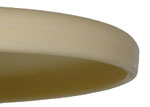Each discs flight characteristics varies depending on a variety of criteria. The thrower, the environment and of course the design of the disc all are factors in how the disc will fly for a particular user. For the purpose of this review we will assume a right handed back hand delivery (or clockwise spin throw). The opposite flight descriptions would be true for a left hand backhand delivery, a right hand forehand delivery (or counter-clockwise throw).
General Flight Terms
- Stable - The disc's flight does not alter much during the high speed portion of the throw. When thrown flat at driving speed, the disc will fly straight.
- Understable - The disc will travel from left to right in the fast part of it's flight then return left when it slows down.
- Overstable - The disc will have a strong tendency to travel from right to left, even in the fast part of the flight.
Functions of a Disc's Flight
- Speed thrown - At low speeds, all discs are more overstable. At high speed, discs will reveal different flight characteristics, a function of mass (weight), speed, environmental conditions and disc design/condition.
- Disc condition - Flight characteristics of all discs change with wear and tear. Discs usually become more understable with wear.
- Weight of disc - The lighter the disc, the easier it is to throw at a high speed per its weight. Because speed is faster compared to weight, lighter discs usually fly less stable. This can be an advantage for throwers that don't have as much speed on their throws (i.e. beginners, women and children).
- Trajectory - The lower the profile of the disc the lower its trajectory should be when releasing the throw. A disc that is domier of taller can be thrown at a higher trajectory.
- Spin - Spin is a factor in maintaining a discs stability.
- Wind (friction) - Into a head wind, discs fly less stable. With the wind, discs fly more stable. Other weather conditions such as rain or snow will also cause the flight of the disc to be less stable.
What's Better for Beginners?
Beginning players should concentrate on relaxed, consistent motion for driving, approaching and putting. Generally speaking, understable to stable discs are easier to throw and achieve greater distance for beginners. Disc speed is easier with lighter weight discs (150 Class Discs) and usually greater distances are realized.
Disc Design

Distance Drivers - Although you can drive with any disc, for the purpose of disc classification we will call a driver any disc with a sharp beveled edge. Some may be overstable and some understable, but all will travel very fast and become overstable at the end of the flight.

Fairway Drivers - Similar in design to distance drivers, fairway drivers tend to have a thinner rim and are generally easier to control. Fairway drivers are ideal for shots outside of your mid-range game when precise control is a must.

Mid-range - These discs are generally the most utilized discs in your bag. They have a beveled edge but are not as sharp as a driver. Appropriate for a wide variety of shots, mid-range discs are designed for maximum control and accuracy. Mid-range discs vary significantly in stability, most players will carry several for appropriate situations.

Putt and Approach - When you can see the links in the chains, it's time to pull out the putter. Putters generally have a slight bevel, some however do not have a beveled edge at all. These discs are usually referred to as "Vintage" discs (see below). Putters are very much personal preference. Try a few, find something you like and stick with it.

Vintage Shape - Discs in this classification meet three WFDF (World Flying Disc Federation) specifications. the first specification is a non-beveled edge; the second is a 6.7 gram per centimeter outside diameter weight limit. The third entails a flexibility standard. Discs of this nature are suggested for short courses, and are excellent for player development.
The 150 Class Weights, Blizzard Plastics and Weight Selection
The success of the 150 class can be explained scientifically. Distance is function of speed, momentum, spin and mass. Lighter discs penetrate quicker because your arm is moving faster relative to the weight of the disc. Maintaining spin holds the disc at an appropriate angle to control a discs flight from beginning to end. An ideal flight path has the disc falling forward at flights end. A disc that tails to the left, right or falls back at flights end is not getting maximum distance. For all players there will be a point of diminishing returns for distance and control when experimenting with different weights. The important thing to remember is that a discs ideal weight will vary by individual. Experimentation is a must to determine what is right for you.
Helpful Hints
If your throws usually tail sharply to one side, you should:
- Throw a lighter disc
- Throw a more understable disc
- Work on the angle and trajectory of release.
If you have more questions about this just shoot us an email and we'll be glad to help.
